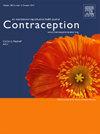“PEOPLE ARE GETTING STERILIZED TO STAY SAFE”: PERMANENT CONTRACEPTION AMONG YOUNG ADULTS AFTER DOBBS
IF 2.8
2区 医学
Q1 OBSTETRICS & GYNECOLOGY
引用次数: 0
Abstract
Objectives
Young people face a unique constellation of barriers to contraception access and are among the most vulnerable groups who may be forced into parenthood following Dobbs v Jackson Women’s Health Organization. The purpose of this study was to measure young adults’ utilization of vasectomy or tubal sterilization after the leaked Dobbs opinion in May 2022, and to examine adolescents’ and young adults’ perceptions about these methods.
Methods
This concurrent mixed-methods analysis used (1) IQVIA medical claims data for 563,273 adults (ages 19-44) from 2021 and 2022 and (2) survey responses from 1,234 adolescents and young adults (ages 14-24) responding to MyVoice surveys in 2022 and 2023. Using claims data, we conducted difference-in-difference analyses of monthly tubal sterilization and vasectomy services among ages 19-26 and 27-44, by state policy category. We conducted thematic content analyses of open-text survey responses from MyVoice, a text-based anonymous poll for individuals ages 14-24.
Results
Tubal sterilization and vasectomy services increased in the months following the Dobbs decision leak for all age groups, with greater increases among ages 19-26 than 27-44. Difference-in-difference analyses found greater increases in tubal sterilization (1%, p=0.02) and vasectomy (2%, p =0.02) in states likely to ban abortion compared to states not likely to ban abortion; state-level differences among ages 27-44 were not statistically significant. Survey responses highlight fear for loss of bodily autonomy and changes to pregnancy plans after Dobbs.
Conclusions
Young adults increasingly obtained permanent contraception post-Dobbs, especially in states deemed likely to ban abortion, and continue to face challenges to their bodily autonomy.
"人们做绝育手术是为了安全":多布斯事件后青壮年中的永久性避孕措施
目标年轻人在获得避孕药具方面面临着一系列独特的障碍,他们是最脆弱的群体之一,在多布斯诉杰克逊妇女健康组织案之后,他们可能会被迫成为父母。本研究的目的是测量 2022 年 5 月多布斯意见书泄露后年轻成人对输精管结扎术或输卵管绝育术的使用情况,并考察青少年和年轻成人对这些方法的看法。方法本并行混合方法分析使用了(1)2021 年和 2022 年 563,273 名成人(19-44 岁)的 IQVIA 医疗索赔数据;(2)2022 年和 2023 年 1234 名青少年和年轻成人(14-24 岁)对 MyVoice 调查的回复。利用索赔数据,我们按州政策类别对 19-26 岁和 27-44 岁人群的每月输卵管绝育和输精管结扎服务进行了差异分析。我们对 "我的声音"(MyVoice)的开放文本调查回复进行了主题内容分析,这是一项针对 14-24 岁个人的基于文本的匿名投票。结果在多布斯决定泄漏后的几个月内,所有年龄组的输卵管绝育和输精管切除服务都有所增加,其中 19-26 岁年龄组的增幅大于 27-44 岁年龄组。差异分析发现,与不可能禁止堕胎的州相比,可能禁止堕胎的州的输卵管绝育手术(1%,p=0.02)和输精管结扎手术(2%,p=0.02)的增幅更大;27-44 岁年龄段的州级差异无统计学意义。结论年轻人在多布斯事件后越来越多地采取永久性避孕措施,尤其是在可能禁止堕胎的州,但他们的身体自主权仍面临挑战。
本文章由计算机程序翻译,如有差异,请以英文原文为准。
求助全文
约1分钟内获得全文
求助全文
来源期刊

Contraception
医学-妇产科学
CiteScore
4.70
自引率
17.20%
发文量
211
审稿时长
69 days
期刊介绍:
Contraception has an open access mirror journal Contraception: X, sharing the same aims and scope, editorial team, submission system and rigorous peer review.
The journal Contraception wishes to advance reproductive health through the rapid publication of the best and most interesting new scholarship regarding contraception and related fields such as abortion. The journal welcomes manuscripts from investigators working in the laboratory, clinical and social sciences, as well as public health and health professions education.
 求助内容:
求助内容: 应助结果提醒方式:
应助结果提醒方式:


